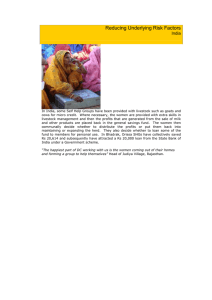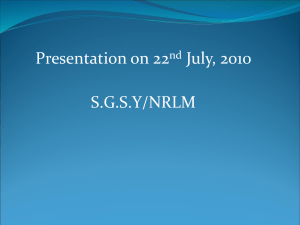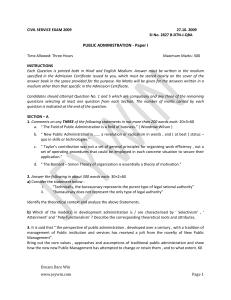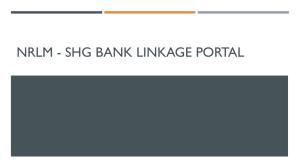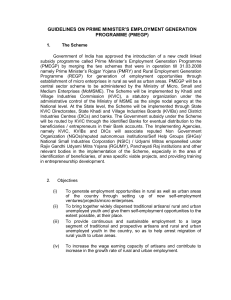Central Government Schemes
advertisement
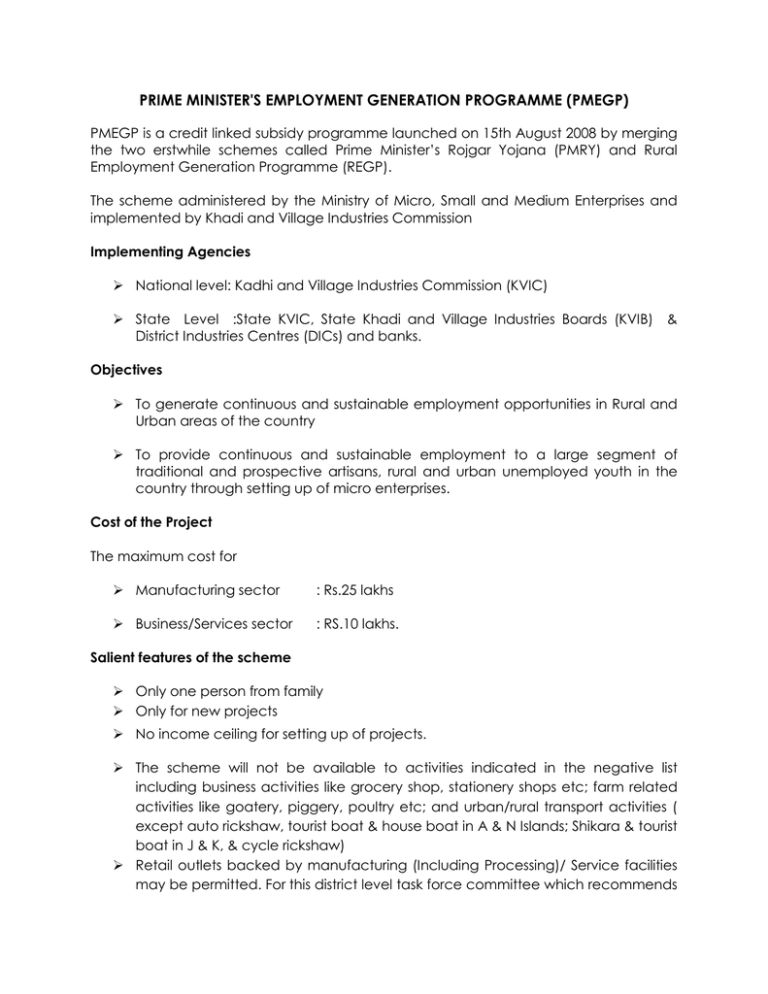
PRIME MINISTER'S EMPLOYMENT GENERATION PROGRAMME (PMEGP) PMEGP is a credit linked subsidy programme launched on 15th August 2008 by merging the two erstwhile schemes called Prime Minister’s Rojgar Yojana (PMRY) and Rural Employment Generation Programme (REGP). The scheme administered by the Ministry of Micro, Small and Medium Enterprises and implemented by Khadi and Village Industries Commission Implementing Agencies National level: Kadhi and Village Industries Commission (KVIC) State Level :State KVIC, State Khadi and Village Industries Boards (KVIB) & District Industries Centres (DICs) and banks. Objectives To generate continuous and sustainable employment opportunities in Rural and Urban areas of the country To provide continuous and sustainable employment to a large segment of traditional and prospective artisans, rural and urban unemployed youth in the country through setting up of micro enterprises. Cost of the Project The maximum cost for Manufacturing sector : Rs.25 lakhs Business/Services sector : RS.10 lakhs. Salient features of the scheme Only one person from family Only for new projects No income ceiling for setting up of projects. The scheme will not be available to activities indicated in the negative list including business activities like grocery shop, stationery shops etc; farm related activities like goatery, piggery, poultry etc; and urban/rural transport activities ( except auto rickshaw, tourist boat & house boat in A & N Islands; Shikara & tourist boat in J & K, & cycle rickshaw) Retail outlets backed by manufacturing (Including Processing)/ Service facilities may be permitted. For this district level task force committee which recommends the case and specifically checked and certified. Such retail outlets backed by manufacturing / service facility can be sanctioned only to new units/ projects under PMEGP. Project cost will include Capital Expenditure and one cycle of Working Capital. Projects without Capital Expenditure are not eligible. Cost of the land should not be included in the Project cost. Cost of ready built as well as long lease or rental work shed can be included in the project cost up to a maximum period of 3 years only. Eligible Entrepreneurs / Borrowers: Individuals above 18 years of age. VIII Std. pass required for project above Rs.10.00 lakhs in manufacturing and above Rs. 5.00 lakhs for Service Sector. Self Help Groups and Charitable Trusts. Institutions Registered under Societies Registration Act- 1860. Production based Co-operative Societies. Repayment 3 to 7 years with an initial moratorium not exceeding 6 months. Security Assets created out of the bank's finance. Personal guarantee of the proprietor / promoter. No collateral security up to Rs. 10 lakhs. Eligible units to be covered under CGMSE. (excluding Margin Money / subsidy component) Margin Money (Subsidy) & Beneficiary’s Margin Categories of beneficiaries under PMEGP General Category Special (including SC/ST/OBC /Minorities/ Women, Ex-Servicemen, Physically handicapped, NER, Hill and Border areas etc) Selection of beneficiaries Beneficiary’s own contribution (of project cost) 10% Rate of Subsidy Urban Rural 15% 25% 5% 25% 35% District level by a Task Force consisting of KVIC/State KVIB/State DICs and Banks. The committee will be headed by the District Magistrate, Deputy Commissioner or Collector of the district. The credit decision rests with the Bank EDP Training After issuance of the sanction order by the financing branch of the Bank and receipt of the copy of the same, the beneficiary must have to undergo EDP training 2-3 weeks at KVIC/KVIB accredited training centres for the purpose of release of funds. The State/Divisional Directors of KVIC, KVIB & DICs will arrange the EDP training to the beneficiaries through KVIC/KVIB/DIC/Ministry of MSME/ Accredited Training Centers within a period of one month of the receipt of the intimation. Release of Bank Loan After successful completion of EDP training producing certificate, the beneficiary will deposit the own contribution. Thereafter Bank will release loan Release of Margin Money (Subsidy) The beneficiary will submit the margin money claim format to the financing branch of the Bank within a period of seven days. The financing branch with their recommendation will forward the claim format to respective nodal branch where KVIC/KVIB/DIC margin money is placed with within a period of 15 days. The nodal branch will release the margin money (subsidy) to financing branch within one month and forward the claim papers to respective offices of KVIC/KVIB/DIC. The financing branch of the Bank, after receipt of the margin money will place the amount under TDR in the name of the beneficiary in the financing branch itself for a period of three years. During this period, no interest will be paid on the TDR and no interest will be charged on the corresponding amount of loan. The time limit for submission of the margin money claim by the beneficiary at the financing branch of the Bank to release of subsidy by the nodal branch of the Bank and receipt of claims at KVIC/KVIB/DIC will be 60 days. Adjustment of margin money subsidy on working capital & Term Loan Adjustment of margin money subsidy on working capital -refund of the margin money subsidy on the difference between subsidies on the sanctioned cash credit limit and the subsidy on the admissible limit, Adjustment of margin money subsidy on term loan, that is, refund of the Margin money subsidy on the difference between the sanctioned term loans and the actually availed term loan. Three year period from the date of first disbursal of the loan or date of ending of lock-in period, whichever is earlier. It should preferably be adjusted after physical verification. However, absence of/delay in physical verification should not impede/delay the adjustment/recovery of the excess margin money subsidy. All PMEGP financing banks have to join the e-tracking mechanism started by KVIC. AAJEEVIKA (National Rural Livelihood Mission) NRLM is the flagship program of Govt. of India for promoting poverty reduction through building strong institutions of the poor, particularly women, and enabling these institutions to access a range of financial services and livelihoods services. NRLM is designed to be a highly intensive program and focuses on intensive application of human and material resources in order to mobilize the poor into functionally effective community owned institutions, promote their financial inclusion and strengthen their livelihoods. NRLM complements these institutional platforms of the poor with services that include financial and capital services, production and productivity enhancement services, technology, knowledge, skills and inputs, market linkage, etc. The community institutions also offer a platform for convergence and partnerships with various stakeholders by building environment for the poor to access their rights and entitlements and public service. Women SHGs and their Federations Women SHGs under NRLM consist of 10-15 persons. In case of special SHGs i.e. groups in the difficult areas, groups with disabled persons, and groups formed in remote tribal areas, this number may be a minimum of 5 persons. NRLM will promote affinity based women Self –help groups. Only for groups to be formed with Persons with disabilities, and other special categories like elders, transgenders, NRLM will have both men and women in the self-help groups. SHG is an informal group and registration under any Societies Act, State However Federations of SHGs formed at village level, cluster level, and at higher levels are to be registered under appropriate acts prevailing in their States. Financial Assistance to the SHGs 1. Revolving Fund (RF): NRLM would provide a Revolving Fund (RF) support to SHGs in existence for a minimum period of 3/6 months and follow the norms of good SHGs, i.e they follow ‘Panchasutra’ – regular meetings, regular savings, regular internal lending, regular recoveries and maintenance of proper books of accounts. Only such SHGs that have not received any RF earlier will be provided with RF, as corpus, with a minimum of Rs. 10,000 and up to a maximum of Rs. 15,000 per SHG. The purpose of RF is to strengthen their institutional and financial management capacity and build a good credit history within the group. 2. Capital Subsidy has been discontinued under NRLM: No Capital Subsidy will be sanctioned to any SHG from the date of implementation of NRLM. 3. Community Investment support Fund (CIF) CIF will be provided to the SHGs in the intensive blocks, routed through the Village level/ Cluster level Federations, to be maintained in perpetuity by the Federations. The CIF will be used, by the Federations, to advance loans to the SHGs and/or to undertake the common/collective socio-economic activities. 4. Introduction of Interest subvention: NRLM has a provision for interest subvention, to cover the difference between the Lending Rate of the banks and 7%, on all credit from the banks/ financial institutions availed by women SHGs, for a maximum of Rs 3,00,000 per SHG Lending Norms: The eligibility criteria for the SHGs to avail loans SHG should be in active existence at least since the last 6 months as per the books of account of SHGs and not from the date of opening of S/B account. SHG should be practicing ‘Panchasutras’ i.e. Regular meetings; Regular savings; Regular inter-loaning; Timely repayment; and Up-to-date books of accounts; Qualified as per grading norms fixed by NABARD. As and when the Federations of the SHGs come to existence, the grading exercise can be done by the Federations to support the Banks. The existing defunct SHGs are also eligible for credit if they are revived and continue to be active for a minimum period of 3 months. Loan amount: Emphasis is laid on the multiple doses of assistance under NRLM. This would mean assisting an SHG over a period of time, through repeat doses of credit, to enable them to access higher amounts of credit for taking up sustainable livelihoods and improve on the quality of life. Type of facility and repayment: SHGs can avail either Term loan or a CCL loan or both based on the need. In case of need, additional loan can be sanctioned even though the previous loan is outstanding. Repayment schedule could be as follows: The first dose of loan will be repaid in 6-12 installments. Second dose of loan will be repaid in 12-24 months. Third dose will be sanctioned based on the micro credit plans, the repayment has to be either monthly/quarterly /half yearly based on the cash flow and it has to be between 2 to 5 Years. Fourth dose onwards: repayment has to be either monthly/quarterly /half yearly based on the cash flow and it has to be between 3 to 6 Years Security and Margin: No collateral and no margin will be charged upto Rs. 10.00 lakhs limit to the SHGs. No lien should be marked against savings bank account of SHGs and no deposits should be insisted while sanctioning loans. Dealing with Defaulters: It is desirable that wilful defaulters should not be financed under NRLM. In case wilful defaulters are members of a group, they might be allowed to benefit from the thrift and credit activities of the group including the corpus built up with the assistance of Revolving Fund. But at the stage of assistance for economic activities, the wilful defaulters should not have the benefit of further assistance until the outstanding loans are repaid. Wilful defaulters of the group should not get benefits under the NRLM Scheme and the group may be financed excluding such defaulters while documenting the loan. Website : http://aajeevika.gov.in/ NATIONAL URBAN LIVELIHOODS MISSION (NULM) The Ministry of Housing & Urban Poverty Alleviation has launched a National Urban Livelihoods Mission (NULM). This has replaced the existing SJSRY from the beginning of the 12th Five Year Plan. NULM would be target-oriented with specific focus on the primary issues pertaining to urban poverty such as skill up-gradation, entrepreneurship development and employment creation through wage employment and self-employment opportunities opened up by the emerging markets in urban areas. To reduce poverty and vulnerability of the urban poor households by enabling them to access gainful self employment and skilled wage employment opportunities, resulting in an appreciable improvement in their livelihoods on a sustainable basis, through building strong grassroots level institutions of the poor. The mission would aim at providing shelters equipped with essential services to the urban homeless in a phased manner. In addition, the mission would also address livelihood concerns of the urban street vendors by facilitating access to suitable spaces, institutional credit, social security and skills to the urban street vendors for accessing emerging market opportunities. Website: http://nulm.gov.in/ COIR UDYAMI YOJANA This is a credit linked subsidy scheme for setting up of coir units with project cost up to Rs.10 lakhs plus one cycle of working capital, which shall not exceed 25% of the project cost. Working capital will not be considered for subsidy. The pattern of assistance under the Scheme is 40% of the project cost as Govt. of India subsidy, 55% as loan from Bank and 5% as beneficiary contribution Under the Coir Udyami Yojana, Marketing Support Assistance to the beneficiaries for the following interventions will also be considered 1. For providing financial assistance for establishing Marketing Consortium of Coir Udyami Yojana beneficiaries. 2. For providing financial assistance for establishing Marketing Consortium of Coir Udyami Yojana beneficiaries 3. For hiring showroom spaces Who can apply? Individuals, Companies, Self Help Groups, Non Governmental Organizations, Institutions registered under Societies Registration Act 1860, Production Co-operative Societies, Joint Liability Groups and Charitable Trust How to apply? The applications can be collected from Coir Board Offices, District Industries Centres, Coir Project Offices, Panchayati Raj Institutions and the Nodal Agencies approved by the Board for this purpose and have to be submitted directly to the Coir Board Field Offices or through the DICs. Website : www.coirboard.gov.in/schemes.htm INDIRA AWAAS YOJANA (IAY) Indira Awaas Yojana is being implemented across the country (except Delhi and Chandigarh) under which financial assistance is provided as Grant-in-Aid to the rural BPL households for construction of a dwelling unit. The ceiling on construction assistance under the Scheme is Rs.45, 000/-per unit in the plain areas and Rs.48,500/- in hilly/difficult areas w.e.f.1.4.2010. For upgradation of kutcha house, the financial assistance is Rs.15,000/- per unit. In addition, IAY houses have been included under the Different Rate of Interest (DRI) scheme for lending upto Rs.20,000 per unit at an interest rate of 4%. Further, the 60 Left Wing Extremism (LWE) affected districts will be eligible for a higher rate of unit assistance of Rs.48,500/- applicable for all sanctions issued w.e.f 01/04/2010 onwards. Under the Scheme, financial resources are shared between the central Govt and the states on a 75:25 basis. In the case of UTs, 100% funding is done by Government of India. However, in the case of North-East States, the funding pattern is in the ratio of 90:10. Website; www.iay.nic.in
